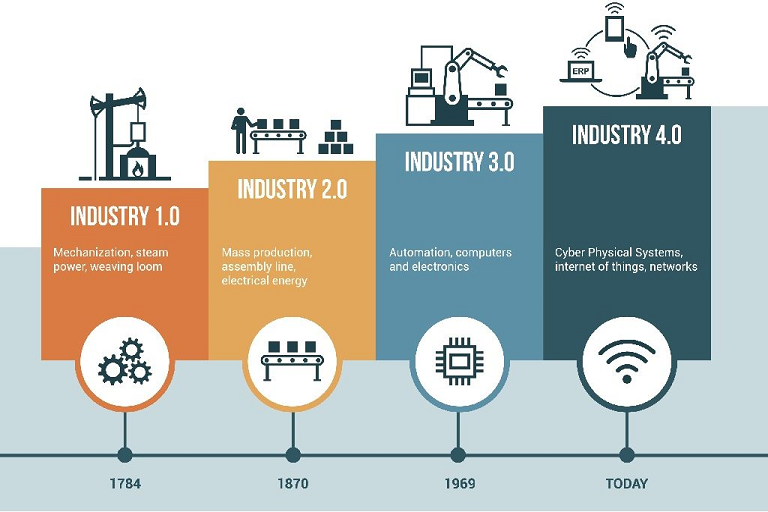MSME Digital Transformation
Learn more about Micro, Small and Medium Businesses adoption of Technology.
The Emergence of Industry 4.0
The digital revolution is in progress - rising and reaching new heights every day. Businesses of all sizes need to adapt and optimise their operations if they don't want to be left behind. Digital solutions have been available for more than three decades now, and huge corporations have been utilising and upgrading their technologies. It used to be an expensive affair to be able to procure technology (hardware & software). However, that's not the case anymore!

Source : https://hammelscale.com/industry-4-0/
Thanks to giants like AWS, Google and players alike, digital technologies are now affordable to smaller businesses. The emergence of Industry 4.0 led to business processes becoming automated, and productivity parameters tweaked, technology like the Cloud and Internet of Things (IoT) is impacting how companies do business.
Get to know more about managing everyone on your company through digital transformation with critical steps to achieving the successful implementation of new workflows and systems. We will explore concepts of disruptive technologies that are changing business along with blockers that keep companies from adopting them as a blog series in a continuation of this. Before we dive into concepts, let us get the basics right.
Digitisation, Digitalisation and Digital Transformation.
All these terms sound the same but mean different things.
Digitisation
Conversion of analogue or physical information to digital format. Transforming physical paper into a digital format represents digitisation. For Eg - Instead of maintaining manual documentation, businesses use computers, tabs and mobile to store data.
Digitalisation
Use of digital technologies to empower or enhance business models and process. For Eg - Use of business accounting software like Tally, Quick Books or Zoho Books enables efficient maintenance of quote, invoice and sales order generation.
Digital Transformation
Coordinated reform effort at scale, distributed through all aspects of the business. A business attains digital transformation when all areas of the company become digitalised, and there is a smooth push and pull of data between teams.
SMEs in the Face of Digitalisation.
MSMEs may be micro, small, and medium businesses by classification, but the impact they have is invaluable. They prevail as the backbone of the economy due to their high share of employment and value-addition.
A refreshed focus on innovation and digitalisation is needed for these companies to engage in global markets. Many segments rely on manual documentation, traditional on-premises deployments. To stay relevant, they need to transform their processes and adopt new tools and systems radically.
Digital transformation is the use of digital technologies to significantly impact all aspects of the business - people, process, technology and metrics.
Digital transformation offers SMEs possibilities to innovate and grow. With the current disruption in technology and the availability of low-cost apps, a micro or small business owner can deploy and use cloud managed services with little or no help.

System of Record to System of Engagement
Companies face pressure to transform as quickly as possible; however, one must understand that each business changes at a different pace with varying results. Manual operations are being automated to improve efficiency, productivity and keep up with competitors.
Digitisation is Only the Beginning
Companies have started to digitize the process, and there is nothing new here, what is new is how data gets utilised. As business progress and the no of transaction increase along with recruits and systems being passed over from one employee to the other, complications and errors start to arise with several data points on multiple sheets. The approach should not end with just a system of record but a system of engagement. To understand this better, let us look at an example.
Microsoft disrupted the operating system market, and most small business would start with office suites and excel in particular for almost all their functions. The companies eventually build their versions of a CRM | Project Management systems in the excel with multiple worksheets and separate files.
Business Insights from Data Interaction
Most data remain static bits of information. Over a period, data accumulates and become redundant. They do not communicate with each other effectively and turn unusable with little or no meaningful business insights. The right approach would have the ability to interact with it, combine it with another information model to produce new ideas. Nothing against excel!
Excel will always remain one of that indisposable software. However, businesses have to move on at one point to a more holistic system of record maintenance, and excel is not a permanent solution.
In the upcoming blog series, we will discuss digital disruptors like Cloud technology, SaaS Products and Mobile Applications and employing them for SMEs.
More from Sixty One Steps

What is Cloud Technology?
Learn about the basics of cloud computing, the delivery models and the deployments methods.
⟵ Previous
Understanding the Basics of CRM
Learn about the concept of CRM and its main applications across different business operations.
Next ⟶Sixty One Steps
We empower brands to adopt technology in the age of digital transformation as Zoho Partners Chennai.

Get in touch
Tel: +91 99620 61061
Drop us an email at: hello@sixtyonesteps.com
Find us
Sixty One Steps Advertising Pvt LtdW660, IVth Ave, Anna Nagar West Extn
Chennai - 600101, TN, India.